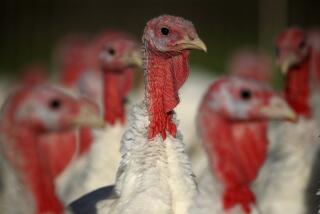Inventor Gives Up Everything to Put Chickens in Lenses : Science: Entrepreneur says red contacts will ease stress in fowl’s life and make it more productive.
- Share via
WELLESLEY, Mass. — Randall E. Wise had it all--a Harvard M.B.A., a profitable computer software company. But he sold his firm to follow a dream, a dream to one day supply contact lenses to all the world’s egg-laying chickens.
Wise’s red contact lenses are already on 100,000 chickens nationwide, and his company, Animalens Inc., is growing.
Oh, sure, people laughed at first. “We’d talk to investors. They’d say: ‘Sounds neat. Good luck,’ ” Wise recalls.
But while Wise is willing to joke a little about his enterprise, he’s all business when it comes to discussing the future, which he says looks sunny side up.
Before writing off Wise as a cuckoo, understand that there is a sound idea behind his scheme. Chickens become positively mellow when they see the world through rose-tinted glasses--or better yet, fire-engine red contact lenses.
Scientists aren’t sure why, but a rosy outlook eliminates the pecking order among chickens, which normally tend to be pretty ornery critters. Red-eyed birds spend less time fighting and more time laying eggs. They also eat less.
According to Wise’s calculations, that translates into an annual savings of at least 50 cents a chicken, or 2.5 cents per dozen eggs. With 1.2 billion laying chickens multiplied by the 20 dozen eggs each yields a year, the savings could be $600 million.
With such benefits, Wise is sure farmers will soon flock to buy his contact lenses, which go for a modest 20 cents a pair, or 15 cents if bought in bulk. The lenses can be put in place in seconds and stay in place for the life of the bird, or about a year.
“The challenge is to go out and sell the product, especially when it’s new and different,” Wise says. “This certainly falls into the category of being new and different.”
The idea for the lenses goes back to Wise’s childhood on the chicken farm his father managed in northern California in the early 1960s.
Wise’s dad, Irvin, tried to produce lenses for chickens after a salesman told him about a farm where chickens afflicted with cataracts behaved better than those with normal sight.
“But the technology didn’t exist at the time for the lens to work,” explains Wise, 41. “The early lenses blinded the chickens.”
The elder Wise’s fledgling company folded. His son went off to college, worked in the shipping industry for a time and then founded a computer software firm in Boston eight years ago that prospered.
But the chickens and the lenses were still on his mind. Three years ago he sold his company for several million dollars and set out to pursue his dream.
“I got out of computers because of this,” Wise says. “And I still don’t miss computers. I’ve believed in this for a long time.”
Not that everything has flown smoothly since jumping from computer software to chicken eye wear.
The lenses had to be painstakingly designed so they wouldn’t distort the chickens’ vision or irritate their eyes. Wise keeps a jar in his office filled with hundreds of pairs of failed test lenses that looks like a container of jelly beans.
“I look at that and I think ‘That’s all behind us,’ ” Wise says. “We already know a lot someone else would have to figure out.”
Eventually, a usable lens was developed. Wise contracted with several small plants around Massachusetts to produce the lenses, and field tests were conducted on farms around the country.
Now, Wise says, the testing is over and it’s time for his dream to fly.
“I’m very confident,” Wise says from his firm’s small suite of offices in this affluent Boston suburb. “1990 is going to be the inflection point for us, when this really takes off.”
More to Read
Inside the business of entertainment
The Wide Shot brings you news, analysis and insights on everything from streaming wars to production — and what it all means for the future.
You may occasionally receive promotional content from the Los Angeles Times.








